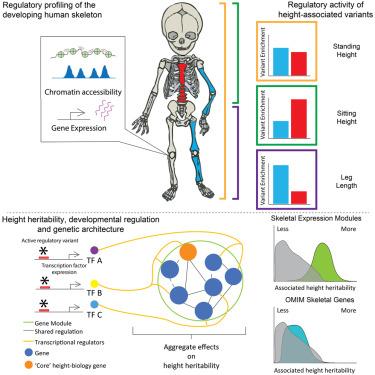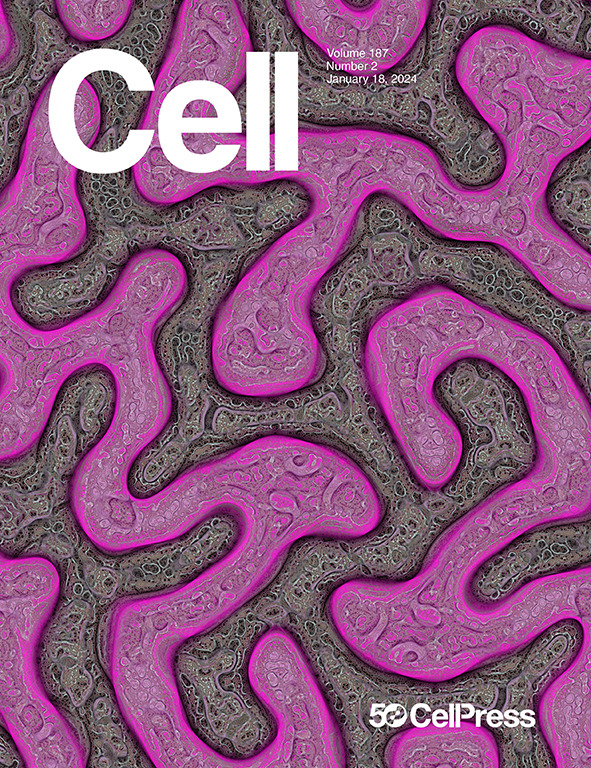人类骨骼发育的功能基因组学与身高遗传的模式化
IF 45.5
1区 生物学
Q1 BIOCHEMISTRY & MOLECULAR BIOLOGY
引用次数: 0
摘要
身高变化的基础是软骨细胞的调控变化,软骨细胞是构成长骨生长板的软骨细胞。目前,我们对整个人体骨骼中软骨细胞的表观遗传调控和基因表达缺乏了解,因此无法理解控制身高生物学的基本调控机制。我们首先纠正了这一问题,从发育中的人类骨骼的不同生长板取样,生成了广泛的软骨细胞表观遗传和转录组图谱,发现了影响人类骨骼/关节发育的新型调控网络。接下来,我们将这些图谱与身高全基因组关联研究(GWAS)信号结合使用,厘清了骨骼元素特异性变异与全局作用变异对骨骼生长的调控影响,揭示了调控多效性在控制身高变异中的首要重要性。最后,由于身高具有高度遗传性,因此通常是复杂性状遗传学的测试案例,我们在一个可测试的全基因模型框架内利用这些数据集来发现新的软骨细胞发育模块和影响身高生物学和骨骼生长的外周作用因子。本文章由计算机程序翻译,如有差异,请以英文原文为准。

Functional genomics of human skeletal development and the patterning of height heritability
Underlying variation in height are regulatory changes to chondrocytes, cartilage cells comprising long-bone growth plates. Currently, we lack knowledge on epigenetic regulation and gene expression of chondrocytes sampled across the human skeleton, and therefore we cannot understand basic regulatory mechanisms controlling height biology. We first rectify this issue by generating extensive epigenetic and transcriptomic maps from chondrocytes sampled from different growth plates across developing human skeletons, discovering novel regulatory networks shaping human bone/joint development. Next, using these maps in tandem with height genome-wide association study (GWAS) signals, we disentangle the regulatory impacts that skeletal element-specific versus global-acting variants have on skeletal growth, revealing the prime importance of regulatory pleiotropy in controlling height variation. Finally, as height is highly heritable, and thus often the test case for complex-trait genetics, we leverage these datasets within a testable omnigenic model framework to discover novel chondrocyte developmental modules and peripheral-acting factors shaping height biology and skeletal growth.
求助全文
通过发布文献求助,成功后即可免费获取论文全文。
去求助
来源期刊

Cell
生物-生化与分子生物学
CiteScore
110.00
自引率
0.80%
发文量
396
审稿时长
2 months
期刊介绍:
Cells is an international, peer-reviewed, open access journal that focuses on cell biology, molecular biology, and biophysics. It is affiliated with several societies, including the Spanish Society for Biochemistry and Molecular Biology (SEBBM), Nordic Autophagy Society (NAS), Spanish Society of Hematology and Hemotherapy (SEHH), and Society for Regenerative Medicine (Russian Federation) (RPO).
The journal publishes research findings of significant importance in various areas of experimental biology, such as cell biology, molecular biology, neuroscience, immunology, virology, microbiology, cancer, human genetics, systems biology, signaling, and disease mechanisms and therapeutics. The primary criterion for considering papers is whether the results contribute to significant conceptual advances or raise thought-provoking questions and hypotheses related to interesting and important biological inquiries.
In addition to primary research articles presented in four formats, Cells also features review and opinion articles in its "leading edge" section, discussing recent research advancements and topics of interest to its wide readership.
 求助内容:
求助内容: 应助结果提醒方式:
应助结果提醒方式:


